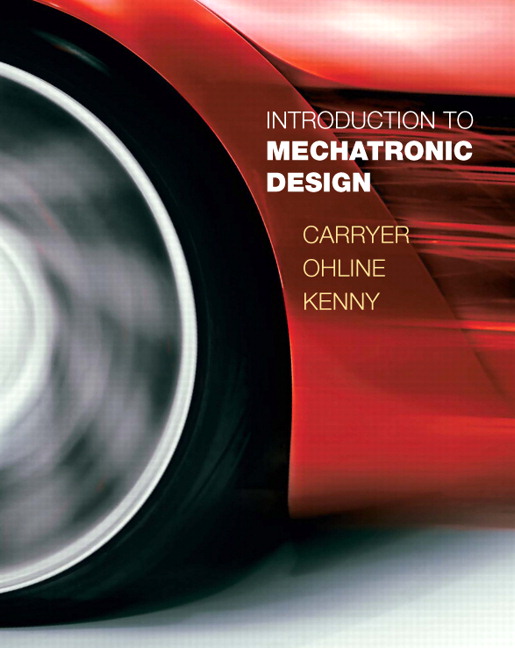Solution Manual for Introduction to Mechatronic Design by Carryer

Product details:
- ISBN-10 : 0131433563
- ISBN-13 : 978-0131433564
- Author: Ed Carryer
Unlike other texts on mechatronics that focus on derivations and calculations, Introduction to Mechatronics, 1e, takes a narrative approach, emphasizing the importance of building intuition and understanding before diving into the math. The authors believe that integration is the core of mechatronics―and students must have a command of each of the domains to create the balance necessary for successful mechatronic design―and devote sections of the book to each area, including mechanical, electrical, and software disciplines, as well as a section on system design and engineering. A robust package of teaching and learning resources accompanies the book.
Table contents:
Chapter 1 Introduction
1.1 Philosophy
1.3 Who Should Study Mechatronics?
1.3 How to Use this Book
1.4 Summary
Part 2: Software
Chapter 2 What’s a Micro?
2.1 Introduction
2.2 WhatISa “Micro”?
2.3 Microprocessors, Microcontrollers, Digital Signal Processors (DSP’s) and More
2.4 Microcontroller Architecture
2.5 The Central Processing Unit (CPU)
2.5.1 Representing Numbers in the Digital Domain
2.5.2 The Arithmetic Logic Unit (ALU)
2.6 The Data Bus and the Address Bus
2.7 Memory
2.8 Subsystems and Peripherals
2.9 Von Neumann Architecture
2.10 The Harvard Architecture
2.11 Real World Examples
2.11.1 The Freescale MC9S12C32 Microcontroller
2.11.2 The Microchip PIC12F609 Microcontroller
2.12 Where to Find More Information
2.13 Homework Problems
Chapter 3 Microcontroller Math and Number Manipulation
3.1 Introduction
3.2 Number Bases and Counting
3.3 Representing Negative Numbers
3.4 Data Types
3.5 Sizes of Common Data Types
3.6 Arithmetic on Fixed Size Variables
3.7 Modulo Arithmetic
3.8 Math Shortcuts
3.8 Boolean Algebra
3.9 Manipulating Individual Bits
3.10 Testing Individual Bits
3.11 Homework Problems
Chapter 4: Programming Languages
4.1 Introduction
4.2 Machine Language
4.3 Assembly Language
4.4 High-Level Languages
4.5 Interpreters
4.6 Compilers
4.7 Hybrid Compiler/Interpreters
4.8 Integrated Development Environments (IDEs)
4.9 Choosing a Programming Language
4.10 Homework Problems
Chapter 5: Program Structures for Embedded Systems
5.1 Background
5.2 Event Driven Programming
5.3 Event Checkers
5.4 Services
5.5 Building an Event Driven Program
5.6 An Example
5.7 Summary of Event Driven Programming
5.8 State Machines
5.9 A State Machine in Software
5.10 The Cockroach Example as a State Machine
5.11 Summary
Homework Problems
Chapter 6 Software Design
6.1 Introduction
6.2 Building as a Metaphor for Creating Software
6.3 Introducing Some Software Design Techniques
6.3.1 Decomposition
6.3.2 Abstraction and Information Hiding
6.3.3 Pseudo-Code
6.4 Software Design Process
6.4.1 Generating Requirements
6.4.2 Defining the Program Architecture
6.4.3 The Performance Specification
6.4.4 The Interface Specification
6.4.5 Detail Design
6.4.6 Implementation
6.4.6.1 Intra-Module Organization
6.4.6.2 Writing the Code
6.4.7 Unit Testing
6.4.8 Integration
6.5 The Sample Problem
6.5.1 Requirements for the Morse Code Receiver
6.5.2 The Morse Code Receiver System Architecture
6.5.3 The Morse Code Receiver Software Architecture
6.5.4 The Morse Code Receiver Performance Specifications
6.5.5 The Morse Code Receiver Interface Specification
6.5.5.1 The Button Module Interface Specification
6.5.5.2 The Morse Elements Module Interface Specification
6.5.5.3 The Morse Decode Module Interface Specification
6.5.5.4 The LCD Display Module Interface Specification
6.5.6 The Morse Code Receiver Detail Design
6.5.6.1 Button Module Detail Design
6.5.6.2 Morse Elements Detail Design
6.5.6.3 Morse Decode Detail Design
6.5.6.4 Display Detail Design
6.5.6.5 Main Detail Design
6.5.7 The Morse Code Receiver Implementation
6.5.8 The Morse Code Receiver Unit Testing. 6-28
6.5.9 The Morse Code Receiver Integration
6.6 Homework Problems
Chapter 7 Communications
7.1: Introduction
7.2: Without a Medium, there is no Message
7.3: Bit-Parallel and Bit-Serial Communications
7.3.1: Bit-Serial Communications
7.3.1.1: Synchronous Serial Communications
7.3.1.2: Asynchronous Serial Communications
7.3.2: Bit Parallel Communications
7.4: Signaling Levels
7.4.1: TTL/CMOS Levels
7.4.2: RS-232
7.4.3: RS-485
7.5: Communicating Over Limited Bandwidth Channels
7.5.1: Telephones and Modems
7.5.1.1: Modulation Techniques
7.5.1.2: Amplitude Modulation (AM)
7.5.1.3: Frequency Modulation (FM)
7.5.1.4: Phase Modulation (PM)
7.5.1.5: Quadrature Amplitude Modulation (QAM)
7.6: Communicating with Light
7.7: Communicating over a Radio
7.7.1: RF Remote Controls
7.7.2: RF Data Links
7.7.3: RF Networks
7.8: Homework Problems
Chapter 8 : Microcontroller Peripherals
8.1 : Accessing the Control Registers
8.2 : The Parallel Input/Output Subsystem
8.2.1 : The Data Direction Register
8.2.2 : The Input/Output Register(s)
8.2.3 : Shared Function Pins
8.3 : Timer Subsystems
8.3.1 : Timer Basics
8.3.2 : Timer Overflow
8.3.3 : Output Compare
8.3.4 : Input Capture
8.3.5 : Combining Input Capture and Output Compare to Control an Engine
8.4 : Pulse Width Modulation (PWM)
8.5 : PWM Using the Output Compare System
8.6 : The Analog-to-Digital (A/D) Converter Subsystem
8.6.1 : The Process for Converting an Analog Input to a Digital Value
8.6.2 : The A/D Converter Clock
8.6.3 : Multiplexer Switching Transients and DC Effects
8.6.4 : Automating the A/D Conversion Process
8.7 : Homework Problems
People also search:
introduction to mechatronic design pdf
introduction to mechatronic design carryer pdf
introduction to mechatronic design pdf download
mechatronic design process
introduction to mechatronics syllabus





